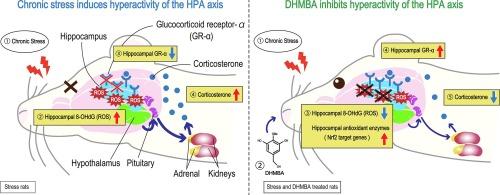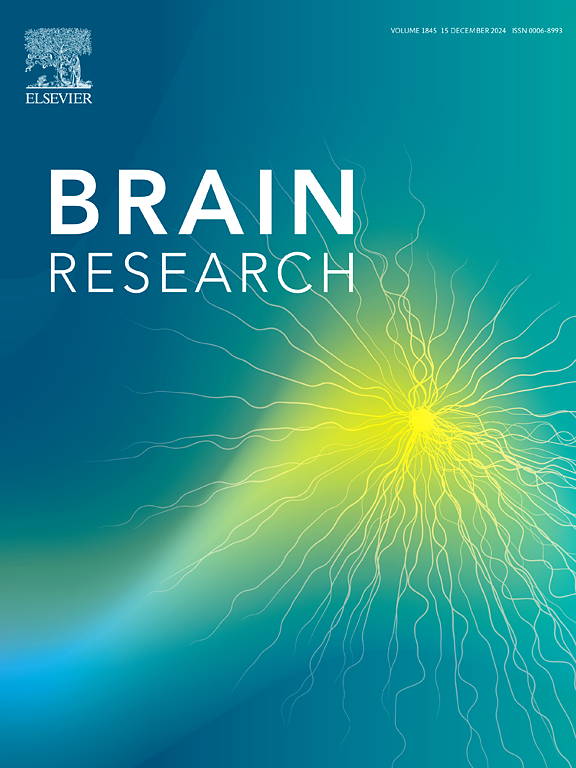3,5-二羟基-4-甲氧基苄醇是从牡蛎肉中分离出来的一种新型抗氧化剂,它能抑制下丘脑-垂体-肾上腺轴,从而调节应激反应。
IF 2.6
4区 医学
Q3 NEUROSCIENCES
引用次数: 0
摘要
背景:目的:我们研究了抗氧化剂3,5-二羟基-4-甲氧基苯甲醇(DHMBA)在大脑中的转运以及给药对应激负荷大鼠下丘脑-垂体-肾上腺(HPA)轴的影响:实验 1:给雌性 B6 小鼠口服 DHMBA 后,随时间推移测量血浆和大脑中 DHMBA 的浓度。实验 2:使用雌性 Wistar Imamichi 大鼠。正常组不承受压力。应激组、DHMBA 组和维生素 E 组受到单独和过度拥挤的应激。测定大鼠大脑和海马的 8-羟基-2'-脱氧鸟苷水平、海马糖皮质激素受体-α水平、血浆皮质酮水平以及海马中谷胱甘肽过氧化物酶 4、过氧化氢酶和谷胱甘肽还原酶的 RNA 水平:实验 1:在服用 DHMBA 之前,血浆和大脑中均未检测到 DHMBA,但在服用后,血浆和大脑中均检测到了 DHMBA。在实验 2 中,DHMBA 组的脑和海马 8-羟基-2'-脱氧鸟苷水平以及血浆皮质酮水平显著低于应激组。DHMBA 组的糖皮质激素受体-α 水平高于应激组。DHMBA增加了海马中抗氧化酶的RNA水平:结论:DHMBA在给药后被转运到大脑。结论:服用DHMBA后,DHMBA被转运到大脑,降低了大脑和海马中8-羟基-2'-脱氧鸟苷的水平,增加了海马糖皮质激素受体-α的水平,降低了血浆皮质酮的浓度,表明DHMBA抑制了HPA轴的过度活跃。DHMBA诱导的Nrf2通路活性增加了海马中抗氧化酶的水平。本文章由计算机程序翻译,如有差异,请以英文原文为准。

3,5-Dihydroxy-4-methoxybenzyl alcohol, a novel antioxidant isolated from oyster meat, inhibits the hypothalamus–pituitary–adrenal axis to regulate the stress response
Background
Antioxidants that can scavenge reactive oxygen in the brain and inhibit hyperactivity of the HPA axis are desirable.
Aims
We investigated the cerebral translocation of the antioxidant 3,5-dihydroxy-4-methoxybenzyl alcohol (DHMBA) and the effects of DHMBA administration on the hypothalamus–pituitary–adrenal (HPA) axis in stress-loaded rats.
Methods
Experiment 1: Plasma and brain DHMBA concentrations were measured over time after oral DHMBA administration to male B6 mice. Experiment 2: Female Wistar Imamichi rats were used. The normal group was not subjected to stress. The stress, DHMBA, and vitamin E groups were subjected to individual and overcrowding stress. Brain and hippocampal 8-hydroxy-2′-deoxyguanosine levels, hippocampal glucocorticoid receptor-α levels, plasma corticosterone levels and RNA levels of glutathione peroxidase 4, catalase, and glutathione reductase in the hippocampus were measured.
Results
In Experiment 1, DHMBA was not detected in the plasma or brain before DHMBA administration but was detected in both after administration. In Experiment 2, brain and hippocampal 8-hydroxy-2′-deoxyguanosine levels and plasma corticosterone levels were significantly lower in the DHMBA than in the stress group. Glucocorticoid receptor-α levels were higher in the DHMBA than in the stress group. DHMBA increased RNA levels of antioxidant enzymes in the hippocampus. Conclusion: DHMBA was translocated to the brain after administration. DHMBA administration decreased 8-hydroxy-2′-deoxyguanosine levels in the brain and hippocampus, increased hippocampal glucocorticoid receptor-α levels, and decreased the plasma corticosterone concentration, suggesting that DHMBA inhibits hyperactivity of the HPA axis. Nrf2 pathway activity induced by DHMBA resulted in increased antioxidant enzyme levels in the hippocampus.
求助全文
通过发布文献求助,成功后即可免费获取论文全文。
去求助
来源期刊

Brain Research
医学-神经科学
CiteScore
5.90
自引率
3.40%
发文量
268
审稿时长
47 days
期刊介绍:
An international multidisciplinary journal devoted to fundamental research in the brain sciences.
Brain Research publishes papers reporting interdisciplinary investigations of nervous system structure and function that are of general interest to the international community of neuroscientists. As is evident from the journals name, its scope is broad, ranging from cellular and molecular studies through systems neuroscience, cognition and disease. Invited reviews are also published; suggestions for and inquiries about potential reviews are welcomed.
With the appearance of the final issue of the 2011 subscription, Vol. 67/1-2 (24 June 2011), Brain Research Reviews has ceased publication as a distinct journal separate from Brain Research. Review articles accepted for Brain Research are now published in that journal.
 求助内容:
求助内容: 应助结果提醒方式:
应助结果提醒方式:


